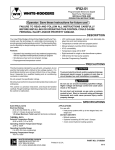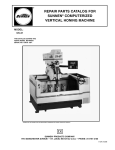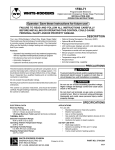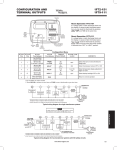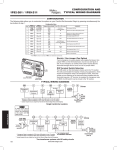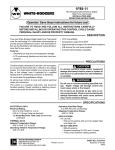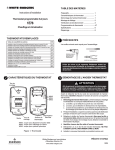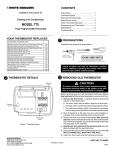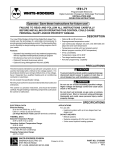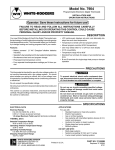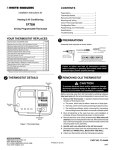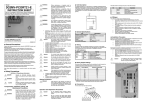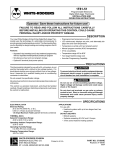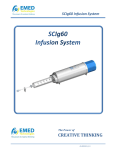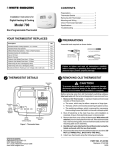Download White Rodgers 1F84-51 User's Manual
Transcript
1F84-51 Programmable Electronic Digital Heat Pump Thermostat INSTALLATION AND OPERATION INSTRUCTIONS WHITE-RODGERS Operator: Save these instructions for future use! FAILURE TO READ AND FOLLOW ALL INSTRUCTIONS CAREFULLY BEFORE INSTALLING OR OPERATING THIS CONTROL COULD CAUSE PERSONAL INJURY AND/OR PROPERTY DAMAGE. DESCRIPTION Your new White-Rodgers 7-Day Digital Heat Pump Thermostat uses the technology of a solid-state microcomputer to provide precise time/temperature control. This thermostat offers you the flexibility to design heating and cooling programs that fit your needs. Features: • • • • Separate program for each day of the week Simultaneous heat and cool program storage Preprogrammed temperature control Four separate time/temperature settings per 24 hour period • LCD continuously displays set point, and alternately displays time and room temperature • Temperature override until next program period • Manual program override (HOLD temperature) • °F/°C convertibility • Temperature range 45° to 90°F • Eight terminals for single or two-transformer systems • O/B terminal for heat pump systems • Armchair Programming Capability PRECAUTIONS This thermostat is intended for use with a 24 volt system; do not use this thermostat with a millivolt or line voltage system. If in doubt about whether your wiring is millivolt, line, or low voltage, have it inspected by a qualified heating and air conditioning contractor or electrician. ! CAUTION To prevent electrical shock and/or equipment damage disconnect electric power to system at main fuse or circuit breaker box until installation is complete. Do not exceed the specification ratings. All wiring must conform to local and national electrical codes and ordinances. This control is a precision instrument, and should be handled carefully. Rough handling or distorting components could cause the control to malfunction. ! WARNING Do not use on circuits exceeding specified voltage. Higher voltage will damage control and could cause shock or fire hazard. Do not short out terminals on gas valve or primary control to test. Short or incorrect wiring will damage thermostat and could cause personal injury and/or property damage. SPECIFICATIONS ELECTRICAL DATA Electrical Rating: 20 to 30 VAC 50/60 Hz. or D.C. 0.05 to 1.5 Amps (Load per terminal) 1.5 Amps Maximum Total Load (All terminals combined) THERMAL DATA Setpoint Temperature Range: 45°F to 90°F (7°C to 32°C) Operating Ambient Temperature Range: 32°F to 105°F Operating Humidity Range: 0 to 90% RH (non-condensing) Shipping Temperature Range: -40°F to 150°F WHITE-RODGERS DIVISION EMERSON ELECTRIC CO. 9797 REAVIS ROAD ST. LOUIS, MISSOURI 63123-5398 APPLICATIONS For use with: • Heat pump systems with up to two stages heat, one stage cool DO NOT USE WITH: • Millivolt systems • Systems exceeding 30 VAC and 1.5 amps • 3-wire zoned hydronic heating systems PART NO. 37-5739A Printed in U.S.A. Replaces 37-5613C 9637 INSTALLATION REMOVE OLD THERMOSTAT 1. Shut off electricity at the main fuse box until installation is complete. Ensure that electrical power is disconnected. 2. Remove the front cover of the old thermostat. With wires still attached, remove wall plate from the wall. If the old thermostat has a wall mounting plate, remove the thermostat and the wall mounting plate as an assembly. 3. Identify each wire attached to the old thermostat using the labels enclosed with the new thermostat. 4. Disconnect the wires from old thermostat one at a time. DO NOT LET WIRES FALL BACK INTO THE WALL. 5. Install new thermostat using the following procedures. W904 CUT FOR NON-ELECTRIC AUX. BATTERY CUTOUT FOR ARMCHAIR PROGRAMMING O B W903 CUT TO DEFEAT EMR ATTACH THERMOSTAT BASE TO WALL 1. Remove the packing material from the thermostat. 2. If necessary, cut the non-electric heat jumper (see NONELECTRIC HEAT SYSTEMS) and/or the EMR jumper (see ENERGY MANAGEMENT RECOVERY). Check the setting of the O/B switch (see O/B TERMINAL SWITCH SELECTION). 3. If you want to program the thermostat before mounting the thermostat on the wall, see ARMCHAIR PROGRAMMING. 4. Gently pull the thermostat cover straight off the base. Forcing or prying on the thermostat will cause damage to the unit. 5. Check that the SYSTEM switch is in the OFF position. Connect wires beneath terminal screws on base using appropriate wiring schematic (see figs. 3 through 5). 6. Place base over hole in wall and mark mounting hole locations on wall using base as a template. 7. Move base out of the way. Drill mounting holes. 8. Fasten base loosely to wall, as shown in fig. 2, using two mounting screws. Place a level against bottom of base, adjust until level, and then tighten screws. (Leveling is for appearance only and will not affect thermostat operation.) If you are using existing mounting holes, or if holes drilled are too large and do not allow you to tighten base snugly, use plastic screw anchors to secure subbase. 9. Push excess wire into wall and plug hole with a fire-resistant material (such as fiberglass insulation) to prevent drafts from affecting thermostat operation. Figure 1. Back of thermostat base Reset Button Screw anchors C L E G W2 R SET TI ME VIEW PRGM RUN Y O/B PRGM HOLD TEMP FAN ON AUTO OFF HEAT COOL EMER Mounting holes Figure 2. Thermostat base programmed period so that the desired temperature is reached at or near the beginning of the next program period (the thermostat calculates 30 minutes for every 2°F temperature change). Read the following information before clipping the non-electric heat jumper. If you are unsure of your application, contact a qualified serviceperson. For example, assume that the thermostat is programmed to provide an overnight heating temperature of 66°F, and during the next program period, beginning at 6:00 AM, the programmed temperature is 70°F. With EMR activated, the thermostat will automatically start the heating system at 5:00 AM, so that the programmed temperature of 70°F is reached by about 6:00 AM. If your emergency or auxiliary system is non-electric (gas, oil, etc.) and will energize the blower, then jumper, W904, on the back of the thermostat base must be cut (see fig. 1). If the overnight room temperature drops only to 68°, the thermostat will start the system at 5:30 to reach the programmed temperature of 70° at 6:00. If your emergency or auxiliary heat system is electric and requires that the thermostat energize the fan circuit, do not cut jumper W904. The thermostat is shipped with the EMR feature active, which means that the thermostat will start the system before the beginning of the next program period. This feature provides better efficiency by allowing gradual temperature changes using only the first stage of heat and cooling. NON-ELECTRIC HEAT SYSTEMS ENERGY MANAGEMENT RECOVERY (EMR) When the EMR feature is activated, the thermostat's microcomputer automatically calculates the time it will take to change the room temperature to the next program setting. Then the thermostat will start the heating or cooling system before the next 2 To de-activate the EMR function, clip wire W903 on the back of the thermostat (see fig. 1). The thermostat will then wait until the programmed time to start the system for a temperature change. This may cause the more costly electric second stage of heating to be used. NOTE NOTE The following wiring diagrams show typical terminal identification and wiring. For proper installation, refer to the original manufacturer's instructions. Relay contacts shown are thermostatically operated. FAN ON FAN AUTO Emer FAN AUTO Heat or Cool O/B Y MALF EMERGENCY THERMOSTAT G Changeover Relay* Thermostat Control Circuit W2 E Fan Relay L C R SYSTEM SYSTEM MONITOR SWITCH Emergency Relay Aux/Emer Relay (Stage 2) Compressor Contactor Hot 24 VAC 120 VAC Neutral TRANSFORMER * Changeover Relay is energized in COOL when O/B switch is in the “O” position Changeover Relay is energized in HEAT when O/B switch is in the “B” position Figure 3. Typical wiring diagram for single transformer systems NOTE FAN ON If safety circuits are in only one of the systems, remove the transformer of the system with NO safety circuits. FAN AUTO Emer FAN AUTO Heat or Cool O/B Y MALF EMERGENCY Thermostat Control Circuit THERMOSTAT G W2 E CUT AND TAPE OFF! Changeover Relay* HOT 24 VAC 120 VAC Fan Relay SYSTEM MONITOR SWITCH Emergency Relay R SYSTEM Limit or Safety Switches Aux/Emer Relay (Stage 2) Compressor Contactor NEUTRAL L C Hot 24 VAC 120 VAC Neutral TWO COMMONS MUST BE JUMPERED TOGETHER! * Changeover Relay is energized in COOL when O/B switch is in the “O” position Changeover Relay is energized in HEAT when O/B switch is in the “B” position TRANSFORMER Figure 4. Typical wiring diagram for two transformer systems with NO safety circuits NOTE FAN ON O/B Y MALF Thermostat Control Circuit EMERGENCY FAN AUTO Emer FAN AUTO Heat or Cool Polarity must be observed. If the HOT side of the second transformer is jumpered to the COMMON side of the first transformer a short will be made. Damage to equipment will occur when power is restored. THERMOSTAT G W2 E L C R SYSTEM Changeover Relay* Compressor Contactor Fan Relay Emergency Relay Limit or Safety Switches SYSTEM MONITOR SWITCH 24 VAC 120 VAC NEUTRAL 24 VAC ACCESSORY RELAY N.O. CONTACT Aux/Emer Relay (Stage 2) Auxiliary Heating Transformer COMMON Limit or Safety Switches TWO COMMONS MUST BE JUMPERED TOGETHER! * Changeover Relay is energized in COOL when O/B switch is in the “O” position Changeover Relay is energized in HEAT when O/B switch is in the “B” position Limit or Safety HOT Switches COMMON NOTE The accessory relay scheme is required when safety circuits exist in both systems. Limit or Safety Switches 24 VAC HOT 120 VAC NEUTRAL Heat Pump Transformer Figure 5. Typical wiring diagram for two transformer systems with safety circuits in BOTH systems 3 O/B TERMINAL SWITCH SELECTION Heating System The O/B switch on this thermostat is factory set to the “O” position. This will accommodate the majority of heat pump applications, which require the changeover relay to be energized in COOL. If the thermostat you are replacing or the heat pump being installed with this thermostat require the “B” terminal, to energize the changeover relay in HEAT, the O/B switch must be moved to the “B” position. 1. Move SYSTEM switch to HEAT position. If the auxiliary heating system has a standing pilot, be sure to light it. ARMCHAIR PROGRAMMING Armchair Programming is a unique feature that allows your thermostat to be programmed before being mounted on the wall. If you do not want to Armchair Program, the thermostat can be programmed after being mounted on the wall and system power turned on. If you wish to Armchair Program your thermostat, temporarily hold a new 9-volt battery against the wires in the battery cutout on the back of the thermostat base for approximately 45 seconds. This will provide a charge that will last approximately 30 to 45 minutes to allow the thermostat to be programmed. After programming, the thermostat must be mounted on the wall, wires connected and system power turned on. NOTE To have sufficient time to complete the installation without losing the programming, hold the 9-volt battery to the terminals on the back of the base for 30 to 45 seconds again after programming the thermostat. The battery must be removed before mounting the thermostat on the wall. ADJUSTABLE ANTICIPATION The first stage has anticipation that can be set to 2.5 or 4 cycles per hour for heating or cooling. The second stage heat has a fixed anticipation. To change the first stage anticipation in the HEAT or COOL mode, press SET TIME and VIEW PRGM buttons at the same time until the desired setting is displayed (S for slow (factory setting) or F for fast). 2. Press to adjust thermostat setting to 90° and hold for five seconds. Both stages of the heating system should begin to operate. However, if the word HEAT is flashing, the compressor lockout feature is operating (see Lockout Bypass Option to temporarily override the compressor lockout feature during testing). 3. Press to adjust temperature setting below room tem- perature. The auxiliary heating system will stop immediately, and the first stage will stop within three to four minutes. Cooling System ! CAUTION To prevent compressor and/or property damage, if the outdoor temperature is below 50°F, DO NOT operate the cooling system. 1. Move SYSTEM switch to COOL position. 2. Press to adjust thermostat setting below room tempera- ture. The blower should come on immediately on high speed, followed by cold air circulation. However, if the fan is running but the compressor is not running and the word COOL is flashing, the compressor lockout feature is operating (see Lockout Bypass Option to temporarily override the compressor lockout feature during testing). 3. Press to adjust temperature setting above room tem- perature. The cooling system should stop operating. LOCKOUT BYPASS OPTION CHECK THERMOSTAT OPERATION If at any time during testing your system does not operate properly, contact a qualified serviceperson. Fan Operation 1. 2. 3. 4. Turn on power to the system. Move SYSTEM switch to OFF position. Move FAN switch to ON. The blower should begin to operate. Move FAN switch to AUTO position. The blower should stop within a short period of time. FOR QUALIFIED SERVICE TECHNICIANS’ USE ONLY. OPERATORS SHOULD NOT USE THIS FEATURE DUE TO POSSIBILITY OF EQUIPMENT OR PROPERTY DAMAGE, OR PERSONAL INJURY. COMPRESSOR SHORT TERM CYCLE PROTECTION This thermostat has a built-in short term (5-minute) time delay. During this 5-minute period, the thermostat will lock out the compressor to allow head pressure to stabilize. If you want to override this feature while testing thermostat operation, simply press and at the same time. DO NOT USE THE LOCKOUT BYPASS OPTION UNLESS THE COMPRESSOR OIL HEATERS HAVE BEEN OPERATIONAL FOR 6 HOURS AND THE SYSTEM HAS NOT BEEN OPERATIONAL FOR AT LEAST 5 MINUTES. 4 OPERATION Before you begin programming your thermostat, you should be familiar with its features and with the display and the location and operation of the thermostat buttons. Your thermostat consists of two parts: the thermostat cover and the base. To remove the cover, gently pull it straight out from the base. To replace the cover, line up the cover with the base and press gently until the cover snaps onto the base. EMER MALF AUX 2 1 THE THERMOSTAT BASE SET TIME VIEW PRGM RUN PRGM HOLD TEMP Other than and , the following buttons and switches are FAN ON OFF AUTO HEAT COOL SET TEMP EMER ADV DAY located behind the door on the bottom of the thermostat cover (see fig. 6). Pull the door down to open it. The Thermostat Buttons and Switches 3 1 (Red arrow) Raises temperature setting. 4 9 2 (Blue arrow) Lowers temperature setting. MO TU WE TH FR 6 7 10 9 HEAT SA SU EMERGENCY 4 VIEW PRGM (program) button. 12 5 RUN PRGM (program) button. 8 AM 11 3 SET TIME/SET TEMP button. 5 13 11 HOLD COOL 14 10 Figure 6. Thermostat display, buttons, and switches 6 HOLD TEMP/ADV DAY button. 7 FAN switch (ON, AUTO). temperature at the selected temperature until the next program period begins. Then the thermostat will automatically revert to the program. • HOLD TEMPERATURE — The thermostat can hold any temperature within its range for an indefinite period, without reverting to the programmed temperature. Press HOLD TEMP/ADV DAY button. HOLD will be displayed. Then 8 SYSTEM switch (COOL, OFF, HEAT, EMER). The Display 9 Indicates day of the week. 10 HEAT is displayed when the SYSTEM switch is in the HEAT position. COOL is displayed when the SYSTEM switch is in the COOL position. COOL or HEAT is displayed (flashing) when the compressor is in lockout mode. 11 Alternately displays current time and temperature. 12 EMERGENCY is displayed when the SYSTEM switch is in the EMER position. 13 Displays currently programmed set temperature (this is blank when SYSTEM switch is in the OFF position). 14 The word HOLD is displayed when the thermostat is in the HOLD mode. OPERATING FEATURES Now that you are familiar with the thermostat buttons and display, read the following information to learn about the many features of the thermostat. • SIMULTANEOUS HEATING/COOLING PROGRAM STORAGE — When programming, you can enter both your heating and cooling programs at the same time. There is no need to reprogram the thermostat at the beginning of each season. • TEMPERATURE OVERRIDE — Press or choose the desired hold temperature by pressing or . The thermostat will hold the room temperature at the selected setting until you press RUN PRGM button to start program operation again. • °F/°C CONVERTIBILITY — Press SET TIME/SET TEMP and HOLD TEMP/ADV DAY buttons until the temperature display is in Celsius (°C). To display Fahrenheit (°F), repeat the process. • TEMPERATURE DISPLAY ADJUSTMENT — Your new thermostat has been accurately set in our factory. However, if you wish, you may adjust your new thermostat temperature display to match your old thermostat. This can be accomplished (within a ±4° range) as follows: 1. Press VIEW PRGM and HOLD TEMP/ADV DAY buttons at the same time. 2. Press or to adjust the displayed temperature to your desired setting. 3. Press RUN PRGM to resume normal program operation. • COPY DAY FUNCTION — This feature allows Monday’s program to be copied into the rest of the week’s programming. This feature is only available the first time you program your thermostat. To use this feature, simply enter the program for Monday as described in PROGRAMMING YOUR THERMOSTAT, and then press RUN PRGM. until the display shows the temperature you want. The thermostat will override current programming and keep the room 5 • RESET BUTTON - (see fig. 2) resets the thermostat program to the factory setting. This button can be used if you do not like the program you have entered or if you wish to start over in the programming procedure. The reset button can also be used to reset the program if the thermostat has been subjected to a voltage spike and the program has become scrambled or frozen. example, heating/cooling period 1 on Monday may begin at 5:00 AM, but heating/cooling period 1 on Saturday may begin at 9:00 AM). Use the table on the following page to plan your program time periods, and the temperatures you want during each period. You may also want to look at the sample program table to get an idea of how the thermostat can be programmed. ENTERING YOUR PROGRAM PROGRAMMING YOUR THERMOSTAT Now you are ready to program your thermostat. This section will help you plan your thermostat’s program to meet your needs. For maximum comfort and efficiency, keep the following guidelines in mind when planning your program. • When heating (cooling) your building, program the temperatures to be cooler (warmer) when the building is vacant or during periods of low activity. • During early morning hours, the need for cooling is usually minimal. Look at the factory preprogrammed times and temperatures shown below. If this program will suit your needs, simply press the RUN PRGM button to begin running the factory preset program. FACTORY PREPROGRAMMING Cooling Program for Heating Program for ALL Days of the Week: ALL days of the Week: PERIOD 1st 2nd 3rd 4th TIME 6:00 AM 8:00 AM 5:00 PM 10:00 PM TEMP 70°F 62°F 70°F 62°F PERIOD 1st 2nd 3rd 4th TIME 6:00 AM 8:00 AM 5:00 PM 10:00 PM TEMP 78°F 85°F 78°F 82°F Heat Temperatures Cool Temperatures 3 4 1 2 3 4 Your selected temperatures* Factory pre-programmed 70°F 62°F 70°F 62°F 78°F 85°F 78°F 82°F temperatures* * You may only program heating temperatures you have selected into the heating program and cooling temperatures into the cooling program (for example, you cannot program the COOL 1 temperature into your heating program). You may program the temperatures you choose in any order, and you may use the same temperature in consecutive program periods (for example, you may program period 1 with temperature 1 and periods 2, 3, and 4 with temperature 2). You do not have to use all possible temperature choices (for example, you may want to select temperatures for HEAT 1 and HEAT 2 only – in this case, the HEAT 3 and HEAT 4 temperatures would stay the same as previously programmed). 2. Determine the time periods during which you will program the temperatures you have just selected. You must program four periods for each day (periods 1, 2, 3, and 4). However, you may use the same heating and cooling temperatures for consecutive time periods. Also keep in mind that, for any given day, you can only program one set of times for both heating and cooling (for example, if you select 5:00 AM to begin heating period 1 on Monday, then your cooling period 1 for Monday will also begin at 5:00 AM). However, you may select different time periods for each day separately (for 6 EXAMPLE: PM 2. Press and hold either or until you reach the correct hour and AM/PM designation (AM begins at midnight; PM begins at noon). 3. Press SET TIME/SET TEMP once. The display window will show the minutes only. 4. Press and hold either 1. Determine the heating and cooling temperatures you want to use. You may select up to four heating temperatures (HEAT 1, HEAT 2, HEAT 3, and HEAT 4), and up to four cooling temperatures (COOL 1, COOL 2, COOL 3, and COOL 4). Use the table below to write down the temperatures you have selected. 2 1. Press SET TIME/SET TEMP button once. The display will show the hour only. EXAMPLE: If you want to change the preprogrammed times and temperatures, follow these steps. 1 Set Current Time and Day or until you reach the correct minutes. 5. Press SET TIME/SET TEMP once. The display will show the day of the week. 6. Press or until you reach the current day of the week. 7. Press RUN PRGM once. The display will show the correct time and room temperature alternately. Select Heating Temperatures 1. If you want to change the display from Fahrenheit to Celsius (or vice-versa), press SET TIME/SET TEMP and HOLD TEMP/ADV DAY at the same time. 2. Move the SYSTEM switch to HEAT. 3. Press SET TIME/SET TEMP four times. The display will show the number 1, along with the currently programmed HEAT 1 temperature. HEAT EXAMPLE: 4. Press or to change the displayed temperature to your selected HEAT 1 setting (if you only want to program a temperature for HEAT 1, skip to step 8). 5. Press SET TIME/SET TEMP once. The number 1 will change to the number 2, representing HEAT 2. 6. Press or until you reach your selected HEAT 2 temperature. 7. Repeat steps 5 and 6 to select HEAT 3 and HEAT 4 temperature settings, if desired. 8. Press RUN PRGM. Heating/Cooling Schedule Plan THIS THERMOSTAT ALLOWS ONE SET OF TIMES FOR BOTH HEATING AND COOLING Period 1 Period 2 Period 3 Period 4 Time Heat Temp. Cool Temp. Time Heat Temp. Cool Temp. Time Heat Temp. Cool Temp. Time Heat Temp. Cool Temp. Monday Tuesday Wednesday Thursday Friday Saturday Sunday HEAT 1 = 65° HEAT 2 = 68° HEAT 3 = 70° HEAT 4 = 72° SAMPLE Heating/Cooling Schedule Plan COOL 1 = 80° COOL 2 = 78° COOL 3 = 76° COOL 4 = 74° THIS THERMOSTAT ALLOWS ONE SET OF TIMES FOR BOTH HEATING AND COOLING Period 1 Period 2 Period 3 Period 4 Time Heat Temp. Cool Temp. Time Heat Temp. Cool Temp. Time Heat Temp. Cool Temp. Time Heat Temp. Cool Temp. Monday 5:00 AM 65° (1) 80° (1) 9:00 AM 65° (1) 80° (1) 3:30 PM 65° (1) 80° (1) 11:30 PM 65° (1) 80° (1) Tuesday 6:00 AM 65° (1) 80° (1) 8:00 AM 70° (3) 76° (3) 4:30 PM 72° (4) 74° (4) 10:30 PM 65° (1) 80° (1) Wednesday 5:00 AM 65° (1) 80° (1) 9:00 AM 70° (3) 76° (3) 3:30 PM 72° (4) 74° (4) 11:30 PM 65° (1) 80° (1) Thursday 5:00 AM 65° (1) 80° (1) 9:00 AM 70° (3) 76° (3) 5:30 PM 72° (4) 74° (4) 11:30 PM 65° (1) 80° (1) Friday 5:00 AM 65° (1) 80° (1) 9:00 AM 70° (3) 76° (3) 3:30 PM 72° (4) 74° (4) 10:30 PM 65° (1) 80° (1) Saturday 8:00 AM 65° (1) 80° (1) 10:00 AM 70° (3) 76° (3) 3:30 PM 72° (4) 74° (4) 11:30 PM 65° (1) 80° (1) Sunday 8:00 AM 70° (3) 78° (2) 9:00 AM 70° (3) 76° (3) 3:30 PM 68° (2) 76° (3) 9:30 PM 65° (1) 80° (1) Enter Heating/Cooling Times and Heating Temperatures 3. If the temperature displayed is not the HEAT 1, 2, 3, or 4 1. Move the SYSTEM switch to HEAT. 2. Press VIEW PRGM once. MO, the abbreviation for Monday, will be displayed. Also displayed are the currently programmed start time for the 1st heating/cooling period and the currently programmed HEAT 1, 2, 3, or 4 temperature for the 1st heating/cooling period (flashing). until the correct temperature is displayed (if you keep press- temperature you want for Monday’s period 1, press ing or or , the HEAT 1, 2, 3, and 4 temperatures you previously programmed will be alternately displayed). 4. To change the displayed start time to the time you have selected for Monday’s heating/cooling period 1, press SET TIME/SET TEMP once (the programmed time will flash). MO EXAMPLE: AM This example display shows that for the 1st Monday heating/ cooling period, the start time is 6:00 AM, and 70° is the programmed temperature (this example reflects factory preprogramming). Press or until your selected time is displayed. The time will change in 30-minute increments. The time that you program will be the start time of Monday’s period 1 for both heating and cooling. After selecting the correct period 1 start time, press SET TIME/SET TEMP again to return to the change temperature mode. 5. Press VIEW PRGM once. The currently programmed start time and heating setpoint temperature for Monday’s heating/ cooling period 2 will be displayed. (Programming instructions continue on next page.) 7 6. Repeat steps 3 and 4 to select the start time and heating temperature for Monday’s 2nd heating/cooling period. 7. Repeat steps 3 through 5 for Monday’s 3rd and 4th heating/ cooling period. Monday’s heating program is now complete. 3. If the temperature displayed is not the COOL 1, 2, 3, or 4 temperature you want for Monday’s period 1, press until the correct temperature is displayed (if you keep pressing NOTE If you are programming your thermostat for the first time, and you want programming for all days of the week to be the same as Monday’s program, press RUN PRGM at this point, and proceed to the SELECT COOLING TEMPERATURES section (this COPY DAY feature only works the first time you program your thermostat; if you are changing your thermostat’s programming, you must program each day separately). 8. Press HOLD TEMP/ADV DAY once. TU (indicating Tuesday’s program) will be displayed, along with the start time for the 1st heating/cooling period and the currently programmed heating setpoint temperature. 9. Repeat steps 3 through 7 to complete Tuesday’s heating program. 10. Continue entering each day’s programming until all heating/ cooling periods and heating temperatures have been selected. 11. Press RUN PRGM to end heating programming. Proceed to the SELECT COOLING TEMPERATURES section. Select Cooling Temperatures 1. Move the SYSTEM switch to COOL. 2. Press SET TIME/SET TEMP four times. The display will show the number 1, along with the currently programmed COOL 1 temperature. 3. Press or to change the displayed temperature to your selected COOL 1 setting (if you only want to program a temperature for COOL 1, skip to step 7). 4. Press SET TIME/SET TEMP once. The number 1 will change to the number 2, representing COOL 2. 5. Press or until you reach your selected COOL 2 temperature. 6. Repeat steps 4 and 5 to select COOL 3 and COOL 4 temperature settings, if desired. 7. Press RUN PRGM. Enter Cooling Temperatures ! CAUTION If the outside temperature is below 50°F, disconnect power to the cooling system before programming. Energizing the air conditioner compressor during cold weather may cause personal injury or property damage. 1. Move SYSTEM switch to COOL position. 2. Press VIEW PRGM once. MO, the abbreviation for Monday, will be displayed. Also displayed are the start time you previously programmed for the 1st heating/cooling period and the currently programmed COOL 1, 2, 3, or 4 temperature for the 1st heating/cooling period (flashing). Remember that the time you previously selected is for both heating and cooling periods. If you change a programmed start time now, it will also change the start time for the heating program. or or , the COOL 1, 2, 3, and 4 temperatures you previously programmed will be alternately displayed). 4. Press VIEW PRGM once. The currently programmed start time and cooling setpoint temperature for Monday’s heating/ cooling period 2 will be displayed. 5. Repeat step 3 to select the cooling temperature for Monday’s 2nd heating/cooling period. 6. Repeat steps 3 and 4 for Monday’s 3rd and 4th heating/ cooling period. Monday’s cooling program is now complete. NOTE If you are programming your thermostat for the first time, and you want programming for all days of the week to be the same as Monday’s program, press RUN PRGM to begin program operation (this COPY DAY feature only works the first time you program your thermostat; if you are changing your thermostat’s programming, you must program each day separately). 7. Press HOLD TEMP/ADV DAY once. TU (indicating Tuesday’s program) will be displayed, along with the start time for the 1st heating/cooling period and the currently programmed cooling setpoint temperature. 8. Repeat steps 3 through 6 to complete Tuesday’s cooling program. 10. Continue entering each day’s programming until all cooling temperatures have been selected. 11. Press RUN PRGM to end programming and begin program operation. CHECK YOUR PROGRAMMING Follow these steps to check your thermostat programming one final time before beginning thermostat operation. 1. Move SYSTEM switch to HEAT position. 2. Press VIEW PRGM to view the 1st Monday heating period time and temperature. Each time you press VIEW PRGM, the next heating period time and temperature for Monday will be displayed in sequence. Press HOLD/ADV DAY to display Tuesday’s 1st heating period program. Press VIEW PRGM to check the remaining Tuesday heating period times and temperatures. To check each day’s heating program, press HOLD TEMP/ADV DAY to change days, then press VIEW PRGM to look at each programming period for the day (you may change any time or temperature during this procedure; remember that if you change the start time, it changes for both heating and cooling). 3. Press RUN PRGM. 4. Move SYSTEM switch to COOL position. 5. Repeat step 2 to check cooling temperatures. 6. Press RUN PRGM to begin program operation. YOUR THERMOSTAT IS NOW COMPLETELY PROGRAMMED AND READY TO AUTOMATICALLY PROVIDE MAXIMUM COMFORT AND EFFICIENCY!








